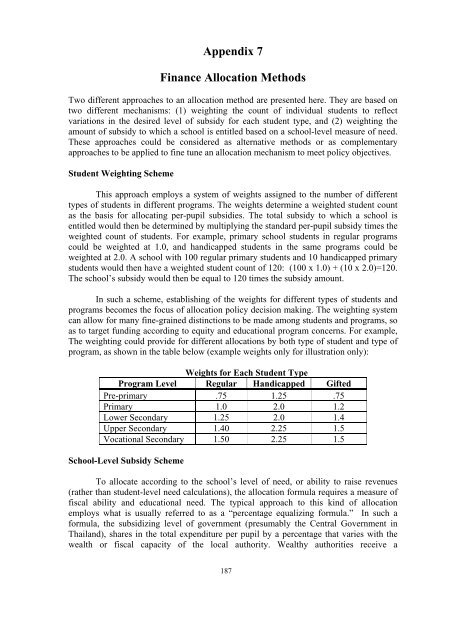Educational Finance in Thailand - UNESCO Bangkok
Educational Finance in Thailand - UNESCO Bangkok
Educational Finance in Thailand - UNESCO Bangkok
Create successful ePaper yourself
Turn your PDF publications into a flip-book with our unique Google optimized e-Paper software.
Appendix 7<br />
<strong>F<strong>in</strong>ance</strong> Allocation Methods<br />
Two different approaches to an allocation method are presented here. They are based on<br />
two different mechanisms: (1) weight<strong>in</strong>g the count of <strong>in</strong>dividual students to reflect<br />
variations <strong>in</strong> the desired level of subsidy for each student type, and (2) weight<strong>in</strong>g the<br />
amount of subsidy to which a school is entitled based on a school-level measure of need.<br />
These approaches could be considered as alternative methods or as complementary<br />
approaches to be applied to f<strong>in</strong>e tune an allocation mechanism to meet policy objectives.<br />
Student Weight<strong>in</strong>g Scheme<br />
This approach employs a system of weights assigned to the number of different<br />
types of students <strong>in</strong> different programs. The weights determ<strong>in</strong>e a weighted student count<br />
as the basis for allocat<strong>in</strong>g per-pupil subsidies. The total subsidy to which a school is<br />
entitled would then be determ<strong>in</strong>ed by multiply<strong>in</strong>g the standard per-pupil subsidy times the<br />
weighted count of students. For example, primary school students <strong>in</strong> regular programs<br />
could be weighted at 1.0, and handicapped students <strong>in</strong> the same programs could be<br />
weighted at 2.0. A school with 100 regular primary students and 10 handicapped primary<br />
students would then have a weighted student count of 120: (100 x 1.0) + (10 x 2.0)=120.<br />
The school’s subsidy would then be equal to 120 times the subsidy amount.<br />
In such a scheme, establish<strong>in</strong>g of the weights for different types of students and<br />
programs becomes the focus of allocation policy decision mak<strong>in</strong>g. The weight<strong>in</strong>g system<br />
can allow for many f<strong>in</strong>e-gra<strong>in</strong>ed dist<strong>in</strong>ctions to be made among students and programs, so<br />
as to target fund<strong>in</strong>g accord<strong>in</strong>g to equity and educational program concerns. For example,<br />
The weight<strong>in</strong>g could provide for different allocations by both type of student and type of<br />
program, as shown <strong>in</strong> the table below (example weights only for illustration only):<br />
Weights for Each Student Type<br />
Program Level Regular Handicapped Gifted<br />
Pre-primary .75 1.25 .75<br />
Primary 1.0 2.0 1.2<br />
Lower Secondary 1.25 2.0 1.4<br />
Upper Secondary 1.40 2.25 1.5<br />
Vocational Secondary 1.50 2.25 1.5<br />
School-Level Subsidy Scheme<br />
To allocate accord<strong>in</strong>g to the school’s level of need, or ability to raise revenues<br />
(rather than student-level need calculations), the allocation formula requires a measure of<br />
fiscal ability and educational need. The typical approach to this k<strong>in</strong>d of allocation<br />
employs what is usually referred to as a “percentage equaliz<strong>in</strong>g formula.” In such a<br />
formula, the subsidiz<strong>in</strong>g level of government (presumably the Central Government <strong>in</strong><br />
<strong>Thailand</strong>), shares <strong>in</strong> the total expenditure per pupil by a percentage that varies with the<br />
wealth or fiscal capacity of the local authority. Wealthy authorities receive a<br />
187

















